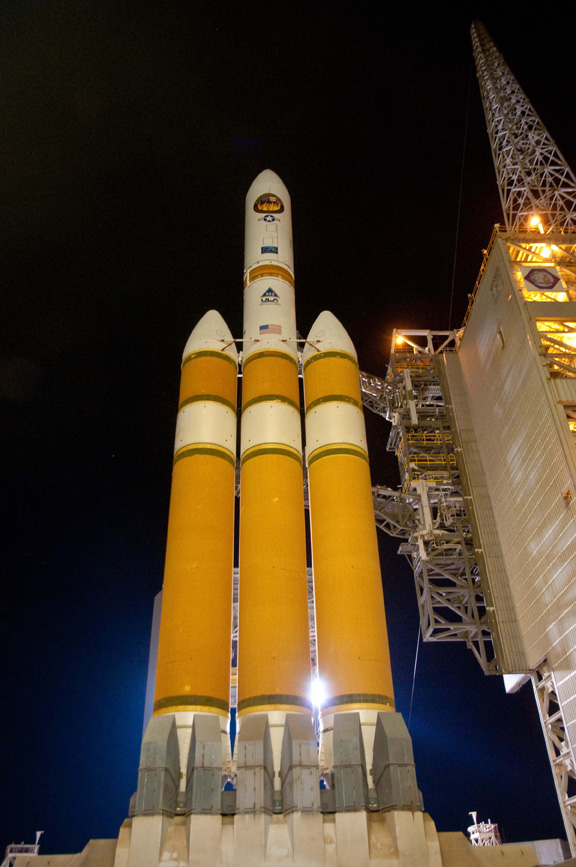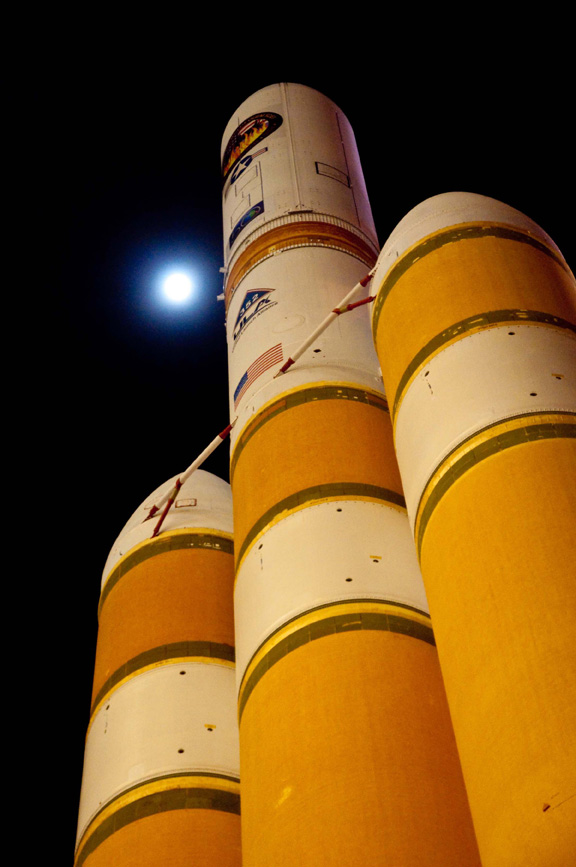Huge Rocket to Launch From U.S. West Coast Today

Ever since the final Titan 4 rocket soared over the horizon from Vandenberg Air Force Base five years ago, the nation lacked the ability to deploy the largest of reconnaissance satellites into polar orbits from the West Coast. But that gap will be closed this week when the modernized replacement makes its California debut.
The Delta 4-Heavy rocket, made by United Launch Alliance, is scheduled for liftoff Thursday at 1:08 p.m. PST (4:08 p.m. EST; 2108 GMT) from Space Launch Complex 6.
The booster is carrying a massive spy satellite like the ones the Titans used to deploy before those rockets were retired from service in 2005.
When the country's lead agency for operating intelligence-gathering spacecraft, the National Reconnaissance Office, ordered another big satellite, plans were set in motion to bring the Delta 4-Heavy to Vandenberg. The western spaceport is the nation's launch site for sending surveillance craft into polar orbits to observe nearly all of the planet's surface.
The SLC-6 pad at Vandenberg, built to support the space shuttles, was ideal for accommodating the Delta 4-Heavy. But engineers liken the complicated machine to launching three rockets at once, and an enhancement to the ground servicing systems was necessary.
"We spent the good part of three years...upgrading the launch pad and the base infrastructure, in total more than $100 million in infrastructure improvements," said Lt. Col. Brady Hauboldt, the Air Force launch director and Vandenberg's 4th Space Launch Squadron commander.
"Most recently over the past year we've completed all pad activation and first article testing with that launch vehicle in place to ensure mission success."
Get the Space.com Newsletter
Breaking space news, the latest updates on rocket launches, skywatching events and more!
The Delta 4-Heavy is created by taking three Common Booster Cores -- the liquid hydrogen-fueled motor that forms a Delta 4-Medium's first stage -- and strapping them together to form a triple-barrel rocket, then adding a cryogenic upper stage. The combined punch can propel about 50,000 pounds of cargo into polar orbit. [Stacking Up the World's Tallest Rockets]
Supplying those four stages with the supercold fluids and commodities, keeping the payload comfortable with conditioned air and the special hardware for servicing the 23-story rocket were among the changes made to the site.
After hosting a pair of medium-class Delta 4 rocket launches in June and November 2006, approval for the Heavy modification work came on December 1, 2006, kicking off a design and analysis period that went to July 2007. Ordering of equipment, fabrication and assembly, the installation and the testing stretched from March 2007 to July 2010.
"(SLC-6) wasn't sized or configured to support the Heavy variant, and that decision goes back quite a few years. In fact, I was at the Pentagon when those decisions were being made. It's ironic now that I get to come back and implement them," said Hauboldt.
More than 835 parts were bought from over 280 suppliers and 35 contractors, and 370 United Launch Alliance employees and hired labor worked on the pad upgrade, according to Jim Boyle, ULA site director at SLC-6.
"We're modifying existing systems that were already here, just adding the capacity in many cases to handle three-of-things, three Common Booster Cores. But it was an extensive effort, took over three years," said Boyle.
"We had very to little to do with the actual structure of the pad -- the concrete, the launch table. It was mostly being able to provide the ability to service."
The specific changes included:
- Installing box-shaped structures, called tail service masts, to route power, data, gases and the vacuum-jacketed liquid hydrogen and liquid oxygen lines to the bottoms of the outboard rocket stages.
- Helium and gaseous nitrogen supply and system upgrades to feed the bigger rocket.
- Propulsion system mods in the pad's pneumatics room and launch mount.
- Enhancing the pad's air conditioning unit and the environmental control system ducts to the rocket.
- Equipping the launch pad's lower swing arm with umbilicals to interface with the outboard boosters.
- Adding an upward extension to the top swing arm for providing air conditioning to the nose cone and payload.
- Adjusting access platforms inside the mobile service gantry.
- Installing a backup generator to power the extra ground support equipment.
- Equipping the pad with cooling water and hydrogen burnoff sparklers for the outboard boosters' main engines.
- And, late in the program, an auxiliary liquid oxygen storage tank was added to give the launch team a capability for multiple countdowns without needing to replenish reserves.
The other substantial effort involved analyzing the sound and rumble the Delta 4-Heavy will created during its slow ascent off the pad.
"There's been some extensive vibration -- noise -- analysis done to look at how the unique Vandenberg terrain effects the payload and the launch vehicle electronics," Hauboldt said.
"Launching a Heavy out of here makes a lot more acoustics, makes a lot more vibrations than a Medium, so we had to go make sure that not only the pad but the rocket could handle those different environments," Boyle added.
The rocket was constructed at ULA's factory in Decatur, Alabama. In mid-August 2009, the three booster cores and upper stage were loaded into ocean-going Delta Mariner vessel for a month-long, 4,000+ mile trip through the Panama Canal and around to Vandenberg.
After arriving late-September 2009 at the harbor once envisioned for receiving the space shuttle fuel tank barge, the first West Coast Heavy rolled onto California soil and moved up the road to SLC-6 over a three-day period.

The Horizontal Integration Facility at the complex is the garage-like hangar were the rocket stages were attached together and tested to verify the Heavy was prepared for the launch pad.
While that assembly work was going on, pad-readiness tests were being run to ensure the site would give the rocket a warm welcome in early 2010.
Riding horizontally on a motorized hauler, the 184,000-pound rocket was driven to the pad where hydraulic pistons pushed the vehicle upright to stand atop the pad on January 29.
The rest of the year was spent doing exhaustive testing to operate pad systems with the rocket and uncover problems that could be fixed before the real countdown on launch day.
"It was an incredibly busy summer, practically like having several other launch campaigns going simultaneously," Hauboldt said.
"It included two tanking tests and numerous wet dress rehearsals to get us comfortable with the systems and configurations. We also had several crew rehearsals to ensure the team was similarly prepared for day of launch. We've exercised our new gaseous nitrogen plant extensively. We've had logistics demonstrations, security demonstrations. The 30th Space Wing has really gone above and beyond to make sure that everything is in place and ready to go for day of launch."
So now the stage is set for liftoff on Thursday, a critical mission carrying a clandestine satellite for the National Reconnaissance Office and the country's intelligence analysts.
"Bringing a new launch vehicle configuration into Space Launch Complex 6 isn't as simple as stacking a new rocket. Although it's a Delta 4, the Heavy configuration required substantial modification and resizing to handle essentially three rockets on the pad at the same time," Hauboldt said.
"This Delta 4-Heavy is the first-of-its-kind national capability here at Vandenberg. We don't currently have this ability to launch any heavy satellites into polar orbit. The Delta 4-Heavy upgrades that we've done at SLC-6 as well as bringing the rocket out here allow us to put satellites of that type into orbit to support our downrange customers."
Copyright 2010 SpaceflightNow.com, all rights reserved.
Join our Space Forums to keep talking space on the latest missions, night sky and more! And if you have a news tip, correction or comment, let us know at: community@space.com.
Stephen Clark is the Editor of Spaceflight Now, a web-based publication dedicated to covering rocket launches, human spaceflight and exploration. He joined the Spaceflight Now team in 2009 and previously wrote as a senior reporter with the Daily Texan. You can follow Stephen's latest project at SpaceflightNow.com and on Twitter.










